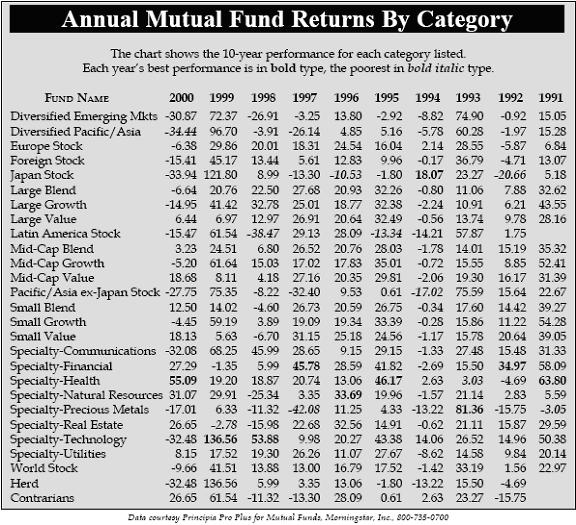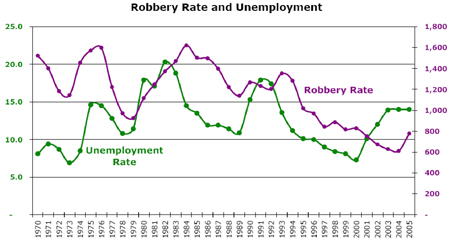Judging from the financial press at the time, Russia’s mid-August default and the ensuing swoon in global markets was a train wreck that inflicted potentially life-threatening wounds on our own economy.
Six weeks after the Big Dive, however, Alan Greenspan administered a kiss that seemed to make it all better: He and his Federal Reserve brethren unexpectedly cut interest rates for the second time since the summer debacle. Markets from here to Hong Kong roared their approval.
Either we have just seen the greatest resuscitative marvel since the Resurrection or the world’s stock and bond traders are suffering from bipolar disorder. I see nothing of Biblical proportion in recent history, so you can guess where I stand. Still, the events of these past months offer a couple of valuable lessons.
The first lesson is what we do not have to worry about — a worldwide deflationary disaster akin to the Great Depression. We heard warnings this year that such a collapse is possible. We heard similar warnings when oil prices plunged in 1986 and the stock market crashed a year later. Yet no such crash has happened since 1929, even though deflationary panics were a regular feature of the business cycle from the early 19th century into the days of FDR.
70-Year Business Cycle?
Seventy years is a heck of a long time for a business cycle, so why has no deflationary crash happened in all that time? In my opinion, it has not happened because, the way our financial system is set up today, it cannot happen. The key difference is in the way money is created.
In the 19th and first part of the 20th century, the world’s money supply was defined by gold and was therefore, in the short term at least, basically fixed. This was a good way to fight inflation, which occurs when too much money chases too few goods. But it could periodically lead to deflation, in which too many goods go in search of too little money. The Industrial Revolution was particularly vulnerable to deflation because the output of goods was rising rapidly while the supply of money rose slowly.
In 1934 President Roosevelt declared that only foreign central banks, not Americans or foreign private citizens, would be allowed to exchange their dollars for gold. Nearly four decades later President Nixon eliminated dollar-gold convertibility even for foreign central banks. These decisions rewrote the rules of international finance. Instead of settling international balances of payments in gold, today we do so in cars, semiconductors, wheat, Walkmans, insurance premiums and hotel nights, in all the goods and services that make up modern trade.
Governments today create money more or less at will. Of course, if a particular government creates more of its money than is justified by its national output, the value of that currency will fall; witness the ruble. If a government is too stingy with its money supply the value of its currency will rise until foreign customers can no longer afford what that country produces. The system swings erratically and sometimes wildly, but it does maintain a rough balance. And since the Depression, the world has not faced an aggregate shortage of money with which to buy goods.
This year’s talk about deflation never made much sense. Deflation must sound like a callous joke to a Russian or an Indonesian who has seen food prices double or worse since mid-1997. American consumers continue to borrow and spend lavishly for big houses, big cars and big vacations amid the lowest interest rates since the Beatles were big. This is hardly a sign that cash is scarce.
Even in Japan, where paralyzed banks have hobbled the entire economy for nearly a decade, official interest rates are near the lowest levels ever recorded, anywhere. True, this does not help if nobody has money to lend at those rates, but the low-rate environment means that once Japan recapitalizes its banks and those banks resume lending, a deflationary bust is extremely unlikely.
My conclusion is that the fears of global deflation are a Chicken Little reaction to a genuine but routine problem. The current threat to our economic expansion comes from the financial woes of our friends and customers overseas, particularly — at the moment — in the Far East, with Latin America perhaps not far behind. With recession looming as a growing threat for 1999, Greenspan & Co. swung into action this fall. Lower rates just might encourage Americans to keep spending and offset the reduced demand from overseas. Maybe the Fed moves will work, maybe they won’t. If not, a simple recession is not the end of life as we know it, not even for Wall Street.
Long Term Problems?
The summer’s real scare, and thus the second lesson, came from the near collapse of Long Term Capital Management, the now-infamous hedge fund operated by some very smart guys who were permitted to do some amazingly dumb things.
Long Term Capital frightened the Fed when it became apparent that leading financial institutions had opened their treasuries to this partnership without having any idea where all the money was going. In fact, it appears that nobody outside Long Term Capital was in any position to know the hedge fund’s overall risk position, and it is evident that those inside Long Term Capital who knew the fund’s position did not understand the implications. The result was a twin threat to the world’s financial structure. A collapse of Long Term Capital might have threatened the strength, if not the viability, of some institutions that are deep into the too-big-to-fail category, while even a threatened fire sale of the fund’s assets could, and for a time did, petrify some key financial markets.
National governments, and not just here in the United States, are going to have to tighten their rules to reduce the risk of a repeat performance. If wealthy individuals and institutions want to put up their own money to speculate in heaven-knows-what, that is their prerogative. But if those tycoons want to play with other people’s money, they are going to have to be a lot more forthcoming with information. It will not suffice to tell each of ten lenders what the fund plans to do with that lender’s little piece of the pie. Clearly, to allow any kind of rational risk management, the big picture will have to be displayed for each prospective creditor to evaluate.
I would not expect the more aggressive hedge funds to be very happy about having to show their hands. Some may even look to lightly regulated offshore funding sources to avoid disclosure. When rewriting the rules, Congress and lawmakers of other industrial powers should try to insulate the big institutions within their borders from the risks of dealing with counter parties whose own financial position is a mystery. Our modern financial system, unsupported by a physical commodity like gold, cannot function well if its true risks and debts go unmeasured.
In their own ways, the deflation scare and the Long Term Capital mishap of 1998 each make the same point. At the dawn of the 21st century money has evolved, from a tangible good that can become cheap or dear, to an intangible representation of the world’s true wealth and a particular nation’s share of it. We are about as likely to run short of money as we are to run short of words. But as with words, money must be backed by substance and information to be worth much.








